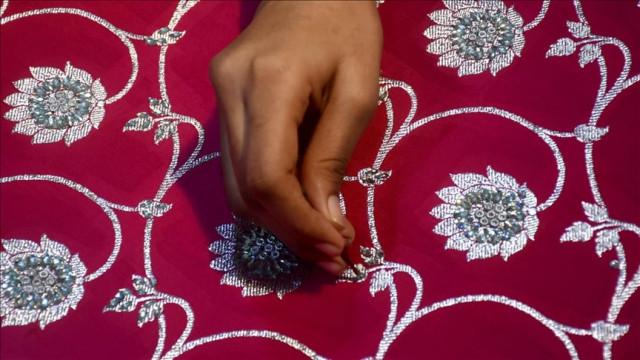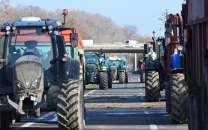Bangladesh resurrects precious woven-air Dhaka muslin
Roughly 200-year-old high-priced handloom-based fabric revived after 6 years of research

Researchers in Bangladesh have resurrected Dhaka muslin, a prized handloom-based fine cotton fabric, with a greater opportunity for commercial production.
Production of the highly prized Mughal-era cloth, which could be passed through a finger ring, was suppressed by the British colonial rulers to promote their own machine-spun muslin and textiles in Indian and European markets.
The Dhaka muslin, named after the Bangladeshi capital, was famous worldwide, especially in Europe in the 17th and early 18th centuries.
There were different types of handloom-based muslin across the Indian subcontinent, but the Dhaka muslin was unique and precious, said Md. Monzur Hossain, a botany professor at the University of Rajshahi and head of the research team.
Read more: Bangladesh’s Pakistani heroes call for burying ‘bitter’ past
“Soon the British realised the value of the Dhaka muslin. They started producing their own muslin by exporting key ingredients, cotton plants, and skilled workers to Europe from Bengal, now Bangladesh. But their machine-spun British textiles weren’t as lucrative or gorgeous as the Dhaka muslin,” Hossain said.
Subsequently, British rulers forcefully stopped the production of the Dhaka muslin by imposing restrictions on weavers.
“There was talk that British rulers cut off fingers of muslin weavers in Dhaka,” he added.
During the pre-colonial Mughal era, Mughal rulers heavily supported the production of the Dhaka muslin, which had faced hostile treatment during the British colonial era, he said, referring to historical archives.
Muslin returns in painstaking effort
Mohsina Akter joined as a spinner at the project four years ago.
“It requires utmost patience and concentration. Your mind needs to be cool and peaceful to spin the fine thread through the wooden spinning wheels,” she said.
Also read: Train services suspended across Bangladesh as staff goes on strike
“I found it the most difficult job on the planet. Only women's soft fingers are required for spinning fine cotton. Spinners have to go through finger treatment and only women spinners can produce fine yarn at the wooden spinning wheels.”
It also requires perfect weather, as hot or unstable air conditions could make it difficult to produce fine cotton, she added.
“It takes eight hours of non-stop labour to weave an inch of cloth. If we lose concentration then it will tear up the yarn and backwards the whole task.”
A research team led by Hossain was formed to resurrect the Dhaka muslin. The team visited the Victoria and Albert Museum in London to view 30 original samples of muslin and analyze them.
“It took about six years of painstaking effort to resurrect something we have never even touched or seen,” he told Anadolu Agency.
First, we advertised across the country if anyone had a sample or knowledge of the Dhaka muslin and the cotton plant named Phuti karpas, a variety of Gossypium arboreum cotton.
“We were unlucky to trace any specimen of the Dhaka muslin in Bangladesh.”
Meanwhile, we collected some known pictures of the cotton plant, without which we cannot weave the Dhaka muslin, and advertised.
Later, they received some 39 samples of cotton plants, including in Gazipur District in the Kapasia subdistrict near the northern part of Dhaka, and luckily one sample’s DNA matched 96%, said Hossain.
In training, we initially trained only six workers in spinning. Now we have 172 spinners and 22 pairs of weavers, said muslin revival project director Mohammad Ayub Ali.
We brought workers from nearby Jamdani saree producing factories and trained them, as Jamdani is also fine cotton produced in a similar way to muslin, he said.
“We set up a Dhaka muslin project near the Rupganj of Dhaka near the Shitalakshya River, where the lost muslin industry was established,” said Ali, who is also a senior official of the state-owned Bangladesh Handloom Board.
Precious muslin 'billion-dollar brand'
“Huge labor and effort are needed to produce a fine Dhaka muslin woven fabric. So, it is highly-priced and the price will not be cut anytime soon. If we can introduce modern textile technology into the process, then it could help,” Hossain said.
There had been 14 separate professional groups involved in producing Dhaka muslin products, including a group involved only in spinning yarn, weaving, and farming the cotton plant, and if such professional groups are set up, then the cost and efforts for muslin production would be cut, he said.
“But still the manual process is highly valued and the specialty of muslin,” Hossain added, saying that “a single saree costs 360,000 takas (around $4,145).”
“There is already a huge market for the Dhaka muslin across the world. We had to visit and meet people of textile industries in so many countries and they showed an interest in commercial production, claiming that the Dhaka muslin is already a billion-dollar brand.”
Government officials, however, said their purpose is to ensure the complete resurrection of the Dhaka muslin.
“We will appreciate any private initiative for commercial production and mass production of the cotton plant. Bangladesh has already secured geographical indication of muslin,” said Ali, referring to a sign used on products that have a specific geographical origin.



1701351241-1/Afghan-refugees-(3)1701351241-1-208x130.webp)















COMMENTS
Comments are moderated and generally will be posted if they are on-topic and not abusive.
For more information, please see our Comments FAQ